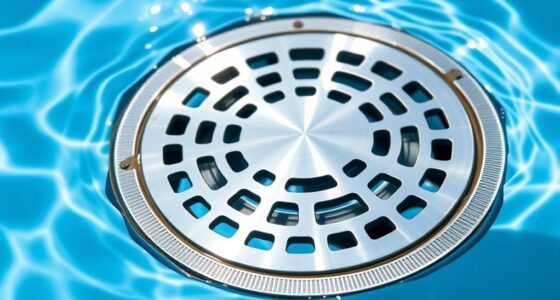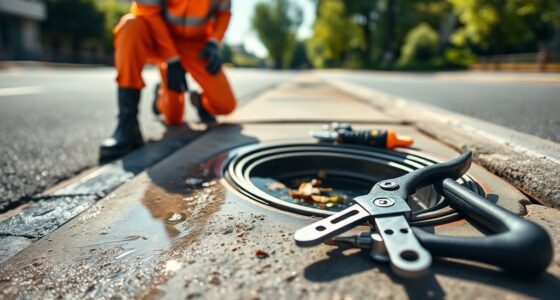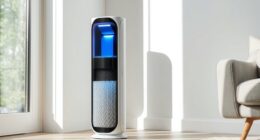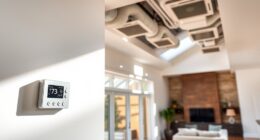To soundproof a rooftop edge for a neighbor-friendly waterfall, start by evaluating noise levels at different times and measuring decibels near your property and neighbors. Use sound-absorbing materials like acoustic foam, mineral wool, or dense vinyl barriers to dampen noise, and design a buffer zone with staggered walls or vegetation to break sound paths. Install proper soundproof barriers and regularly maintain them. Continue exploring detailed tips to achieve an effective, peaceful solution.
Key Takeaways
- Measure existing noise levels and sound travel to identify critical areas needing soundproofing.
- Use dense, sound-absorbing materials like acoustic foam or mineral wool around the waterfall.
- Create buffer zones with staggered walls or vegetation to diffuse and block sound before reaching neighbors.
- Install sealed soundproof barriers such as mass-loaded vinyl around the waterfall structure and rooftop perimeter.
- Regularly inspect and maintain barriers, filters, and equipment to sustain noise reduction effectiveness.
Assessing the Noise Levels and Sound Propagation
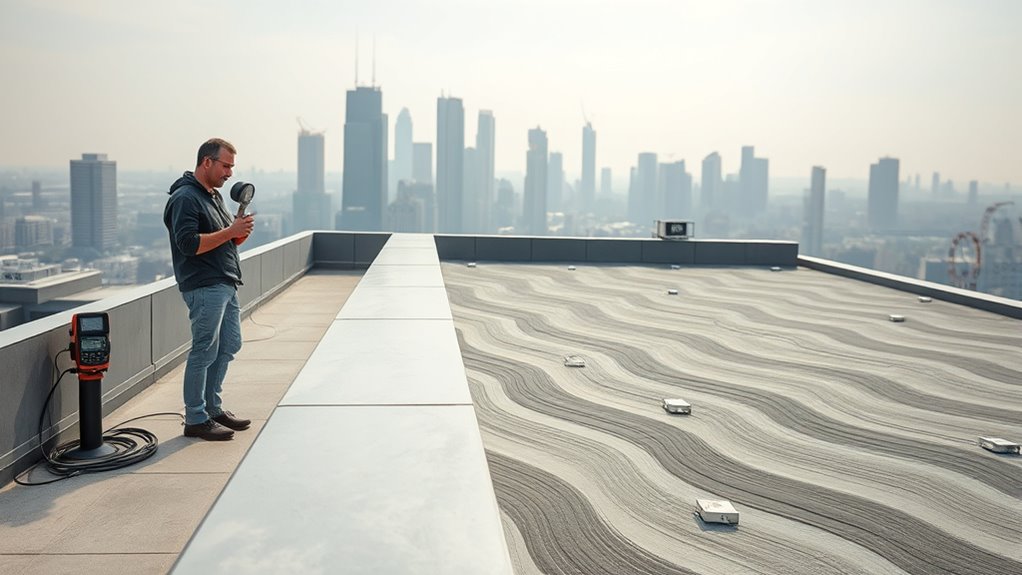
How do you determine the noise levels and understand sound propagation around your rooftop edge? Start by listening at different times of the day to identify peak noise periods. Use a sound level meter to measure decibel levels—aim for readings near your rooftop edge and at neighboring properties. Note how sound travels across open spaces and around obstacles, which helps you identify sound escape routes. Observe how loud noises are at various distances; this reveals how sound diminishes with distance. Consider wind and weather conditions, as they can influence sound movement. By gathering this data, you’ll know where noise is most prominent and how it spreads, enabling you to plan effective soundproofing strategies for your rooftop waterfall. Additionally, understanding the contrast ratio of nearby projectors can help you optimize your environment for quieter operation and reduce noise pollution.
Selecting Sound-Absorbing Materials for Your Waterfall Edge
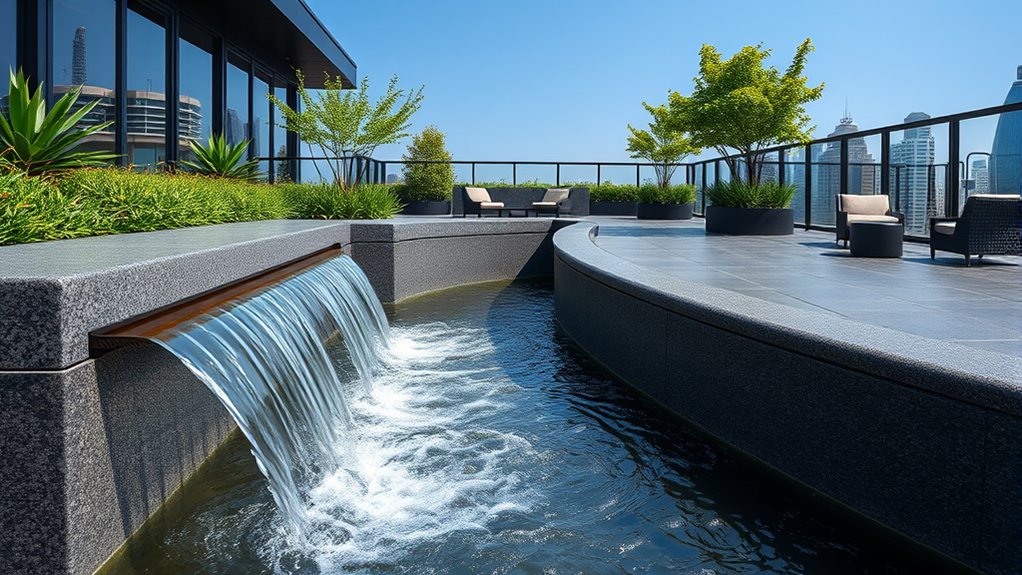
Once you’ve assessed the noise levels and understand how sound travels around your rooftop edge, selecting the right sound-absorbing materials becomes a key step in reducing noise. Focus on materials that absorb sound waves rather than reflect them. Acoustic foam panels or mineral wool are effective choices, as they dissipate sound energy and cut down on echo. You can also consider installing dense mass-loaded vinyl barriers, which block sound transmission. For a more natural look, use weather-resistant materials like thick rubber mats or treated fabrics that blend with your rooftop design. Remember to cover both the waterfall structure and nearby surfaces to maximize absorption. Proper placement and layering of these materials ensure you create a quieter environment that’s neighbor-friendly without sacrificing aesthetic appeal. Incorporating soundproofing techniques can further enhance the effectiveness of your setup and help create a peaceful outdoor space.
Designing a Buffer Zone to Minimize Sound Transmission
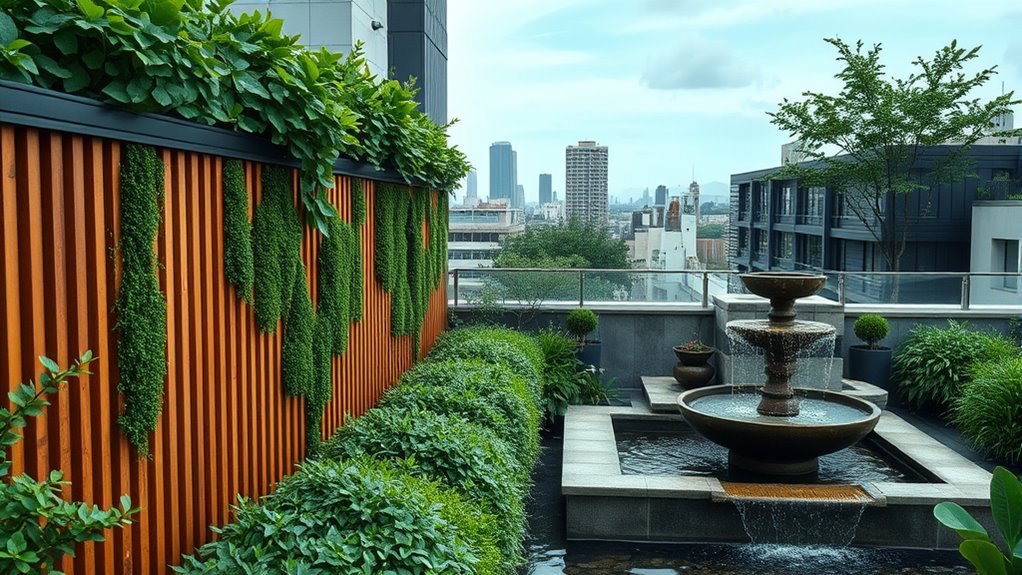
Creating a well-designed buffer zone is essential for effectively reducing sound transmission from your rooftop edge. It acts as a barrier that absorbs and disperses sound waves before they reach neighboring spaces. Start by adding layers of dense, sound-absorbing materials such as mass-loaded vinyl, acoustic panels, or thick insulation within the buffer zone. Incorporate strategic features like staggered walls or angled surfaces to deflect sound rather than reflect it directly. Elevate the buffer zone with vegetation or decorative barriers, which can further dampen noise. Certify the zone is sufficiently spaced from the waterfall source to break the direct path of sound waves. Additionally, understanding soundproofing measures can help optimize the effectiveness of your buffer zone. By carefully designing this area, you create an effective buffer that minimizes noise impact on neighbors while enhancing your rooftop’s acoustical environment.
Installing Soundproof Barriers and Enclosures

Installing soundproof barriers and enclosures is a essential step in minimizing noise from your rooftop edge. These barriers act as physical blocks, absorbing and deflecting sound waves before they reach neighboring spaces. You can choose materials like dense foam, mass-loaded vinyl, or specially designed panels to enhance effectiveness. Proper placement and sealing are critical to prevent sound leaks. For example, installing barriers around your waterfall’s base or along the rooftop perimeter can markedly reduce noise transmission. Consider different configurations to suit your space and aesthetic preferences. Here’s a quick comparison:
| Barrier Type | Benefits |
|---|---|
| Mass-Loaded Vinyl | Highly effective at sound blocking |
| Acoustic Panels | Easy to install, customizable appearance |
| Enclosures | Contain noise, shield surroundings |
| Dense Foam | Absorbs high-frequency sounds |
Additionally, understanding the importance of soundproofing materials can help you select the most effective options for your specific needs.
Maintenance Tips for Sustaining a Quiet Waterfall Experience
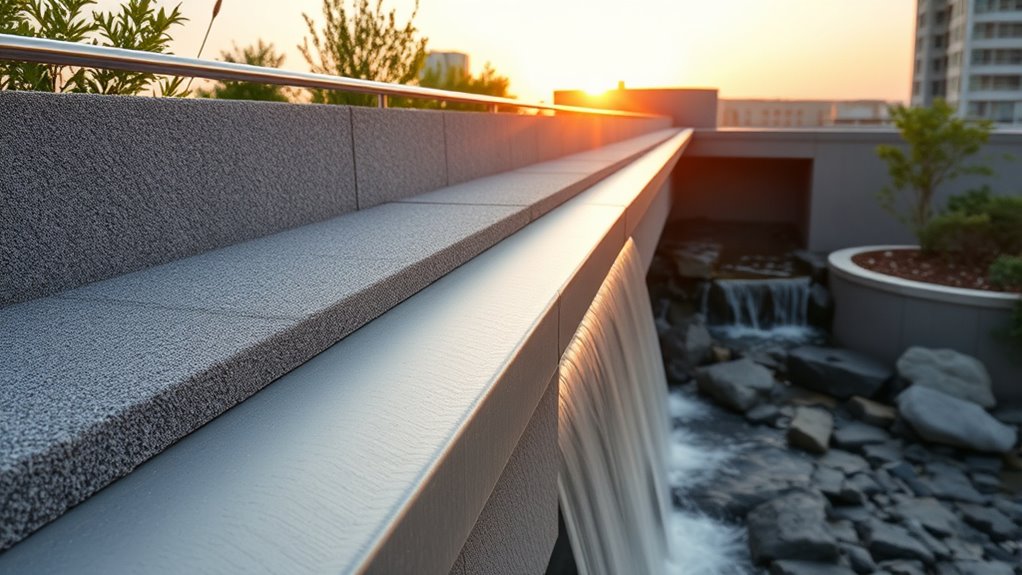
To maintain a consistently quiet waterfall experience, regular inspection and prompt upkeep are essential. Start by checking soundproof barriers and enclosures for any damage or wear, like cracks or loose fittings. Clean filters, pumps, and surrounding surfaces to prevent debris buildup that can cause noise or reduce effectiveness. Verify water levels are consistent, as fluctuations can lead to increased noise or strain on equipment. Lubricate moving parts periodically to minimize squeaking or rattling sounds. Monitor for leaks or cracks in the structure and address them immediately to prevent sound escape. Keep vegetation trimmed around the waterfall to reduce sound reflection and interference. Additionally, understanding industry trends can help you stay informed about new noise reduction technologies and techniques. Finally, schedule professional inspections annually to identify hidden issues early and keep your water feature operating quietly and efficiently.
Frequently Asked Questions
How Does Weather Affect Soundproofing Effectiveness Over Time?
Weather can considerably impact your soundproofing over time. Rain, snow, and humidity may cause materials to deteriorate or shift, reducing their effectiveness. Extreme temperatures can expand or contract soundproof layers, creating gaps or cracks. Wind can also carry noise past barriers. To maintain ideal soundproofing, you should regularly inspect and maintain your setup, replacing or reinforcing materials affected by weather conditions.
Can DIY Soundproofing Solutions Match Professional Installations?
DIY soundproofing solutions can be effective, but they rarely match the quality of professional installations. While you can save money and customize your approach, professionals have access to specialized materials and expertise that guarantee better sound absorption and durability. Don’t underestimate the importance of proper technique; a poorly installed DIY project may fall short long-term. For ideal results, consider a professional assessment, especially for complex or high-traffic areas.
Are There Eco-Friendly Soundproofing Options Available?
Yes, eco-friendly soundproofing options are available. You can choose natural materials like recycled cotton, sheep’s wool, or cellulose insulation, which effectively absorb sound while being environmentally responsible. Plant-based barriers, such as green walls or dense shrubbery, also help reduce noise pollution. These options not only protect your neighbors’ peace but also promote sustainability, making your soundproofing efforts both effective and eco-conscious.
How Do I Balance Aesthetics With Soundproofing Efficiency?
You can balance aesthetics with soundproofing efficiency by choosing stylish, natural materials like bamboo or moss panels that blend seamlessly with your rooftop design. Incorporate decorative elements such as planters or artistic screens to hide soundproofing components. Opt for sleek, modern designs that complement your space while absorbing sound effectively. Regularly update your decor to keep it visually appealing, ensuring your soundproofing solutions enhance both tranquility and your rooftop’s aesthetic appeal.
What Are the Legal Requirements for Noise Levels in Residential Areas?
Did you know that 75% of cities have noise ordinances? Legally, you must keep noise levels below local limits, often around 55-65 decibels during daytime and lower at night. Check your city’s specific ordinances, as violations can result in fines or legal action. To stay compliant, use soundproofing techniques like barriers or water features designed to minimize noise. Always verify local regulations before making significant changes.
Conclusion
By soundproofing your rooftop waterfall, you create a peaceful oasis amid the urban noise. Imagine the gentle cascade muffled behind barriers, while vibrant city life continues nearby—in perfect harmony. With mindful material choices and strategic design, you turn a lively spectacle into a serene retreat. Ultimately, your effort transforms a noisy neighbor into a tranquil haven, proving that peace and sound can coexist beautifully on your rooftop.



